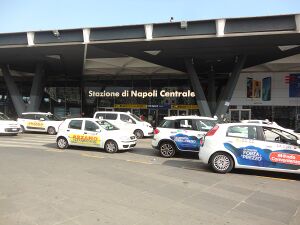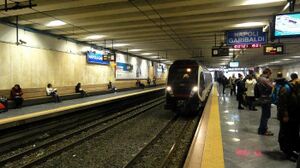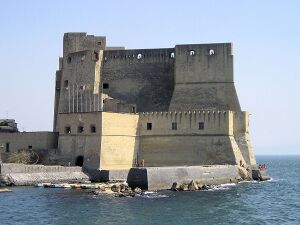Napoli
| Napoli | |||||
|---|---|---|---|---|---|
| Japanese Name | ナポリ | ||||
| Weapon | |||||
| Race | Elf | ||||
| Nationality | |||||
| Birthday | May 7 | ||||
| Constellation | Taurus | ||||
| Talents | Making huge structures with condensed ash | ||||
| Likes | Pizza | ||||
| Dislikes | Things that hide beautiful scenery | ||||
| Strengths | Earnest and good-natured | ||||
| Weaknesses | Terribly clumsy | ||||
| Hobbies | Urban walks, making pizza | ||||
Napoli is from M. Verforet, from a place called Cenere City, sì. It used to be so full of beautiful nature. Now it is all covered by volcanic ash, except for some parts... That's why Napoli has the Wise Saggia who teaches how to clean up the ashes sì.
Layers
| Icon | Title | Release Date | Where to Obtain |
|---|---|---|---|
| [The Philosopher's Apprentice] Napoli | 2021 December 8 | [Training Camp - Napoli] Event Reward | |
| [The Magician of Ash] Napoli | 2021 December 1 | [Magical School Trip in the Town of Ash] Event Reward | |
| [A Clean and Gentle World] Napoli | 2021 November 30 | [Magical School Trip in the Town of Ash] Pick Up Gacha, Premium Gacha |
Owned Skills
Trivia
- Napoli's birthday is the opening date of Napoli Centrale railway station in 1867.
- Napoli's ash magic and back story of Napoli and "the Town of Ash" is themed after Mount Vesuvius and the destroyed Roman city of Pompeii. The ruins of Pompeii was buried under 4 to 6 m (13 to 20 ft) of volcanic ash and pumice in the eruption of Mount Vesuvius in AD 79.
- Pizza is said to originate from Naples/Napoli. Margherita pizza, also known as Naples-style pizza, is a style of pizza made with tomatoes and mozzarella cheese. The tomatoes must be either San Marzano tomatoes or Pomodorino del Piennolo del Vesuvio, which grow on the volcanic plains to the south of Mount Vesuvius.
- Termini's pet name for Napoli, "Napolitan", is a pun on several things: the word "Neapolitan" that describes something or someone from Naples, ナポリタン/Naporitan which is a Japanese pasta dish of spaghetti and ketchup, and "Napoli-tan" with "-tan" as a childish pronunciation of the honorific "-chan", used for young women/girls in a friendly context.
- Napoli's harsh upbringing likely comes from Naples' reputation as a rough, crime-ridden city dominated by mafia families known as Camorra.
- The building in the background of [A Clean and Gentle World] is the Castel dell'Ovo, a seafront castle in Naples, Italy.
- Napoli's [A Clean and Gentle World] outfit is of a Pulcinella, a classical character that originated in commedia dell'arte of the 17th century and became a stock character in 1600s puppetry. When depicted as a member of the servant class, Pulcinella is a perverted bumpkin. His main motivations are self-interest and self-preservation, yet Pulcinella tends to rescue other characters from trouble.
- [A Clean and Gentle World] sprite shows Napoli eating a lemon. Lemons in Italy are most often grown on the Amalfi Coast of Naples and in Sicily.
Counterpart
Napoli Centrale (Naples Central Station) (IATA: INP) is the main railway station in the city of Naples and in southern Italy and the sixth largest station in Italy in terms of passenger flow with an annual ridership of 50 million. It is located next to Piazza Garibaldi to the east of the old city. It is the primary rail terminus and station for Naples, and serves Trenitalia national railways and EAV. This one has an underground section known as Stazione di Napoli Piazza Garibaldi (Naples Garibaldi Piazza station), which is served by the metropolitan trains of the line 2, line 1 (Garibaldi), and 3, 12, 14, and 15 EAV Circumvesuviana lines which is accessible from 2 entrances inside the Centrale station, 1 outside in glass, and from the new Garibaldi Square.
The first station on the site was built in 1866 on a design by the architect Enrico Alvino and it was opened on 7 May of the following year. The current station was designed in 1954 by Pier Luigi Nervi, Carlo Cocchia, Massimo Battaglini, Bruno Zevi, Giulio De Luca, Luigi Piccinato and Giuseppe Vaccaro on the site of the old railway station and overlooks the square dedicated to Giuseppe Garibaldi. The project was completed in 1960. The station has undergone a deep restyling lasting five years and finished in August 2010, which concerned both the platform and the underground floor, with the installation of new escalators, elevators, lights, benches, shops and the replacement of the original floors made in black linoleum with a more modern white tile covering.
Among the architectural elements that distinguish the station is the "pyramid" roof also made famous by a carousel starring Mina, in which the singer walked dressed in huge telephone cables between the pyramids of the roof itself (footage also used for the video of the song "Se telefonando," whose music was composed by Ennio Morricone). Also bold and innovative were the inverted pyramidal pillars (inverted tripods) supporting the canopies placed at the station entrance and at the head of the tracks.
The station has 25 tracks. It is connected to Rome by high-speed trains on the Rome–Naples high-speed railway line as well as slower trains on the original Rome–Cassino–Naples line and the Rome–Formia–Naples Direttissima opened in 1927. It is connected to Salerno and southern Italy by the traditional Naples–Salerno line and the recently opened Naples–Salerno high-speed line used by long distance trains. Wikipedia
Castel dell'Ovo ("Egg Castle") is a seafront castle in Naples, located on the former island of Megaride, now a peninsula, on the Gulf of Naples in Italy. The castle's name comes from a legend about the Roman poet Virgil, who had a reputation in the Middle Ages as a great sorcerer and predictor of the future. In the legend, Virgil put a magical egg into the foundations to support the fortifications. It remains there along with his bones, and had this egg been broken, the castle would have been destroyed and a series of disastrous events for Naples would have followed. The castle is located between the districts of San Ferdinando and Chiaia, facing Mergellina across the sea.
The Castel dell'Ovo is the oldest standing fortification in Naples. The island of Megaride was where Greek colonists from Cumae founded the original nucleus of the city in the 6th century BC. Its location affords it an excellent view of the Naples waterfront and the surrounding area. In the 1st century BC the Roman patrician Lucius Licinius Lucullus built part of the magnificent villa, later called Castellum Lucullanum, on the site. Fortified by Valentinian III in the mid-5th century, it was the site to which the last western Roman emperor, Romulus Augustulus, was exiled in 476. Eugippius founded a monastery on the site after 492.
In the 19th century a small fishing village called Borgo Marinaro, which is still extant, developed around the castle's eastern wall. It is now known for its marina and restaurants. The castle is rectangular in plan, approximately 200 by 45 metres at its widest, with a high bastion overlooking the causeway that connects it to the shore; the causeway is more than 100 metres long and a popular location for newlyweds to have their wedding photos taken. Inside the castle walls are several buildings that are often used for exhibitions and other special events. Behind the castle there is a long promontory once probably used as a docking area. A large round tower stands outside the castle walls to the southeast. Wikipedia












